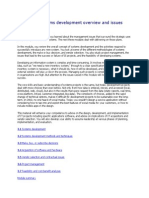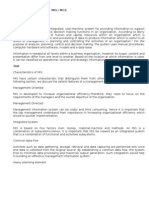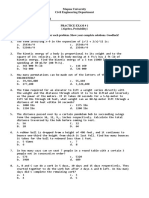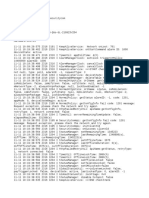0 ratings0% found this document useful (0 votes)
50 viewsCW1 M1
The document discusses the advantages and challenges of implementing project management information systems in the construction industry. The key advantages are that it enhances productivity, enables better collaboration, supports remote working, facilitates effective risk mitigation, and allows for effective task delegation. However, the document also notes that most such systems fail when implemented due to challenges like a lack of knowledge about the systems, implementing solutions without a unified vision, solutions being too expensive, and internal political issues between departments.
Uploaded by
Dani LubosCopyright
© © All Rights Reserved
Available Formats
Download as PDF, TXT or read online on Scribd
0 ratings0% found this document useful (0 votes)
50 viewsCW1 M1
The document discusses the advantages and challenges of implementing project management information systems in the construction industry. The key advantages are that it enhances productivity, enables better collaboration, supports remote working, facilitates effective risk mitigation, and allows for effective task delegation. However, the document also notes that most such systems fail when implemented due to challenges like a lack of knowledge about the systems, implementing solutions without a unified vision, solutions being too expensive, and internal political issues between departments.
Uploaded by
Dani LubosCopyright
© © All Rights Reserved
Available Formats
Download as PDF, TXT or read online on Scribd
You are on page 1/ 1
Lubos, Daniela S.
June 03, 2022
CLASSWORK No.1 CE175-3C/A26
1. A project management information system presents timely information or data, allowing to
make an appropriate decision and generate a more successful completion of the
construction project. The following are considered advantages in implementing project
management information systems in the construction industry: (1) enhancing productivity;
(2) better collaboration; (3) remote working; (4) effective risk mitigation; (5) effective task
delegation. Utilizing a project management information system enhances productivity since
all the essential details are found in a single system, optimizing the decision-making process.
An optimized methodology is created where processes, templates, and procedures are
saved and will be able to reuse on other projects. Communication is done in a suitable place,
which can be done in a single click, providing a better collaboration with other members
within the project. Sometimes, members are from different departments it is hard to attend
meetings and be updated. Necessary alerts are sent, and project timelines are accessible in
the system, resulting in unified works. The third advantage is remote working since
workforces are scattered, managing them is challenging, yet implementing the project
management information system helps have an efficient lead for the teams. Next is effective
risk mitigation, considering all the resources at hand in the information system strategies in
resolving bottlenecks and problems are enhanced. Efficient countermeasures are deployed
to improve the overall work in the project. Lastly, assigning tasks to each team member is
complex, affecting the competence of the whole team. Available members are easy to find,
making it simple to delegate tasks. Also, some programs send reminders before the
deadlines ensuring smooth operations.
2. Most project management information systems implemented in the construction industry
fail. The following are the challenges in implementing the system: (1) lack of knowledge; (2)
wrong team is implementing the solution; (3) lack of unified vision; (4) expensive; (5)
internal politics. Project managers and team members are busy as always; hence, they don’t
have time to evaluate and learn new technical skills on their current tools. The lack of
knowledge hinders the implementation of the system. Since construction professionals can’t
implement the system right, it is passed and handled by another department such as IT,
which does not have a background in the construction. The IT department will build
solutions that are not grounded on how the works in the field are performed. The best breed
of the software is attracting the companies which do not fit their needs. The company is not
aware of the tools needed by the member resulting in complicated and more complex tasks.
That best-breed is expensive, making it challenging to implement, considering multiple
programs are required. Lastly, in internal politics, various departments compromise a team
involved in the projects where each has its workflows and platforms. Utilizing one system for
all departments causes a disparate and resistance to adopting the information system since
it does more work for them.
You might also like
- Modelling & Simulation MCQ Questions & Answers - Dapzoi100% (3)Modelling & Simulation MCQ Questions & Answers - Dapzoi8 pages
- Critical Failure Factors in Information System Projects: K.T. YeoNo ratings yetCritical Failure Factors in Information System Projects: K.T. Yeo6 pages
- Bit 3201 Object Oriented Analysis and Design Assignments - Docx BKPNo ratings yetBit 3201 Object Oriented Analysis and Design Assignments - Docx BKP4 pages
- School of Civil, Environmental and Geological Engineering: INSTRUCTION: Provide On What Is Being Asked Per ItemNo ratings yetSchool of Civil, Environmental and Geological Engineering: INSTRUCTION: Provide On What Is Being Asked Per Item2 pages
- 1.0 Objective: Prototyping Model Was AdoptedNo ratings yet1.0 Objective: Prototyping Model Was Adopted28 pages
- Critical Failure Factors in Information System ProjectsNo ratings yetCritical Failure Factors in Information System Projects6 pages
- Event Management System VB Net Project ReportNo ratings yetEvent Management System VB Net Project Report71 pages
- Web-Based Project Management System For Team CollaborationNo ratings yetWeb-Based Project Management System For Team Collaboration32 pages
- Design of Project Management Information SystemsNo ratings yetDesign of Project Management Information Systems7 pages
- LaRon Walker - Untrained Users and Information Systems DevelopmentNo ratings yetLaRon Walker - Untrained Users and Information Systems Development6 pages
- Online Job Portal Java Project DocumentNo ratings yetOnline Job Portal Java Project Document92 pages
- Event Management System VB Net Project ReportNo ratings yetEvent Management System VB Net Project Report71 pages
- BSC (Hons) Business Management Cohort 2 Bmp4005 Information Systems and Big Data AnalysisNo ratings yetBSC (Hons) Business Management Cohort 2 Bmp4005 Information Systems and Big Data Analysis10 pages
- Event Management System VB Net Project ReportNo ratings yetEvent Management System VB Net Project Report70 pages
- Timetable Distribution System: Department of Computer Science & Information TechnologyNo ratings yetTimetable Distribution System: Department of Computer Science & Information Technology17 pages
- A Project Report Submitted in Partial Fulfillment of100% (1)A Project Report Submitted in Partial Fulfillment of14 pages
- Blantyre International University Systems Analysis & Design Assignment 1No ratings yetBlantyre International University Systems Analysis & Design Assignment 18 pages
- The Problems of Project Management Software ImplemNo ratings yetThe Problems of Project Management Software Implem5 pages
- CTM-632 Construction Information System SolutionsNo ratings yetCTM-632 Construction Information System Solutions25 pages
- Laudon - Management Information Systems-Pages-2No ratings yetLaudon - Management Information Systems-Pages-26 pages
- Case Study For Reasons of Software Projects Failure: STUDENT NAMES: Ashenafi GadisaNo ratings yetCase Study For Reasons of Software Projects Failure: STUDENT NAMES: Ashenafi Gadisa21 pages
- SCDL - Pgdba - Finance - Sem 2 - Mis-McsNo ratings yetSCDL - Pgdba - Finance - Sem 2 - Mis-Mcs18 pages
- A Web - Based Project Management System for FFJJ Construction in Navotas CityNo ratings yetA Web - Based Project Management System for FFJJ Construction in Navotas City10 pages
- Chapter 2 Auditing It Governance ControlsNo ratings yetChapter 2 Auditing It Governance Controls54 pages
- Different Techniques of Software Design: TEAM NO.:-17. Team MembersNo ratings yetDifferent Techniques of Software Design: TEAM NO.:-17. Team Members6 pages
- S D I: A P S: Ystem Esign and Mplementation Ilot TudyNo ratings yetS D I: A P S: Ystem Esign and Mplementation Ilot Tudy5 pages
- LUBOS, Daniela S. CE133P-2/A1 June 15, 2021No ratings yetLUBOS, Daniela S. CE133P-2/A1 June 15, 20213 pages
- Instruction:: Lubos, Daniela S. June 11, 2021 Module Exam 1 GED103/C2No ratings yetInstruction:: Lubos, Daniela S. June 11, 2021 Module Exam 1 GED103/C21 page
- Subject 1 Algebra Trigonometry Plane Geometry Solid Geometry Analytic Geometry Probability PhysicsNo ratings yetSubject 1 Algebra Trigonometry Plane Geometry Solid Geometry Analytic Geometry Probability Physics49 pages
- Database Design and Management: The Relational ModelNo ratings yetDatabase Design and Management: The Relational Model38 pages
- = + + + 2 Ω+1 Ω+5 Ω=8 Ω = = 20 V 8 Ω = 2.5 A = = 2.5 A ×2 Ω=5V = 2.5 A ×1 Ω=2.5V = 2.5 A ×5 Ω=12.5 VNo ratings yet= + + + 2 Ω+1 Ω+5 Ω=8 Ω = = 20 V 8 Ω = 2.5 A = = 2.5 A ×2 Ω=5V = 2.5 A ×1 Ω=2.5V = 2.5 A ×5 Ω=12.5 V4 pages
- Standard Error P P N 1 N 4 P P P) P P: SolutionNo ratings yetStandard Error P P N 1 N 4 P P P) P P: Solution5 pages
- Toshiba Satellite C655D-S5209 Review and SpecsNo ratings yetToshiba Satellite C655D-S5209 Review and Specs7 pages
- CSS - 06-Week 3 - Module 3 - Windows Server R2 Configuration100% (1)CSS - 06-Week 3 - Module 3 - Windows Server R2 Configuration25 pages
- Salesforce Certified Administrator-Exam GuideNo ratings yetSalesforce Certified Administrator-Exam Guide6 pages
- Design and Implementation of Token Stealing Kernel Shellcode For Windows 8No ratings yetDesign and Implementation of Token Stealing Kernel Shellcode For Windows 812 pages
- "Password Generating System": Micro-Project Report ON86% (7)"Password Generating System": Micro-Project Report ON11 pages
- Top 10 Java Interview Questions On Final KeywordNo ratings yetTop 10 Java Interview Questions On Final Keyword3 pages
- Project Management Questions: Is The Statement of Work The Same As The Project Charter?No ratings yetProject Management Questions: Is The Statement of Work The Same As The Project Charter?2 pages
- The Solution For Campus Security Brochure PDFNo ratings yetThe Solution For Campus Security Brochure PDF12 pages
- Stat 5.7.1 Patch App Instructions 14AUG2014No ratings yetStat 5.7.1 Patch App Instructions 14AUG201440 pages
- ZTE SDR BTS Introduction - V2.00 - 20130403No ratings yetZTE SDR BTS Introduction - V2.00 - 2013040363 pages
- Analog Communication by U.a.bakshi A.P. Godse PDFNo ratings yetAnalog Communication by U.a.bakshi A.P. Godse PDF3 pages
- Shivam Gupta - 1171788818 - Project ReportNo ratings yetShivam Gupta - 1171788818 - Project Report74 pages



















































































































